AZ-120 : Planning and Administering Microsoft Azure for SAP Workloads : Part 01
AZ-120 : Planning and Administering Microsoft Azure for SAP Workloads : Part 01
- Case Study This is a case study. Case studies are not timed separately. You can use as much exam time as you would like to complete each case. However, there may be additional case studies and sections on this exam. You must manage your time to ensure that you are able to complete all questions included on this exam in the time provided. To answer the questions included in a case study, you will need to reference information that is provided in the case study. Case studies might contain exhibits and other resources that provide more information about the scenario that is described in the case study. Each question is independent of the other questions in this case study. At the end of this case study, a review screen will appear. This screen allows you to review your answers and to make changes before you move to the next section of the exam. After you begin a new section, you cannot return to this section. To start the case study
To display the first question in this case study, click the Next button. Use the buttons in the left pane to explore the content of the case study before you answer the questions. Clicking these buttons displays information such as business requirements, existing environment, and problem statements. If the case study has an All Information tab, note that the information displayed is identical to the information displayed on the subsequent tabs. When you are ready to answer a question, click the Question button to return to the question. Overview Litware, Inc. is an international manufacturing company that has 3,000 employees. Litware has two main offices. The offices are located in Miami, FL, and Madrid, Spain. Existing Environment Infrastructure Litware currently uses a third-party provider to host a datacenter in Miami and a disaster recovery datacenter in Chicago, IL. The network contains an Active Directory domain named litware.com. Litware has two third-party applications hosted in Azure. Litware already implemented a site-to-site VPN connection between the on-premises network and Azure. SAP Environment Litware currently runs the following SAP products:- Enhancement Pack6 for SAP ERP Central Component 6.0 (SAP ECC 6.0)
– SAP Extended Warehouse Management (SAP EWM)
– SAP Supply Chain Management (SAP SCM)
– SAP NetWeaver Process Integration (PI)
– SAP Business Warehouse (SAP BW)
– SAP Solution Manager All servers run on the Windows Server platform. All databases use Microsoft SQL Server. Currently, you have 20 production servers. You have 30 non-production servers including five testing servers, five development servers, five quality assurance (QA) servers, and 15 pre-production servers. Currently, all SAP applications are in the litware.com domain. Problem Statements The current version of SAP ECC has a transaction that, when run in batches overnight, takes eight hours to complete. You confirm that upgrading to SAP Business Suite on HANA will improve performance because of code changes and the SAP HANA database platform. Litware is dissatisfied with the performance of its current hosted infrastructure vendor. Litware experienced several hardware failures and the vendor struggled to adequately support its 24/7 business operations.Requirements
Business Goals
Litware identifies the following business goals:
– Increase the performance of SAP ECC applications by moving to SAP HANA. All other SAP databases will remain on SQL Server.
– Move away from the current infrastructure vendor to increase the stability and availability of the SAP services.
– Use the new Environment, Health and Safety (EH&S) in Recipe Management function.
– Ensure that any migration activities can be completed within a 48-hour period during a weekend.Planned Changes
Litware identifies the following planned changes:
– Migrate SAP to Azure.
– Upgrade and migrate SAP ECC to SAP Business Suite on HANA Enhancement Pack 8.Technical Requirements
Litware identifies the following technical requirements:
– Implement automated backups.
– Support load testing during the migration.
– Identify opportunities to reduce costs during the migration.
– Continue to use the litware.com domain for all SAP landscapes.
– Ensure that all SAP applications and databases are highly available.
– Establish an automated monitoring solution to avoid unplanned outages.
– Remove all SAP components from the on-premises network once the migration is complete.
– Minimize the purchase of additional SAP licenses. SAP HANA licenses were already purchased.
– Ensure that SAP can provide technical support for all the SAP landscapes deployed to Azure.-
You are evaluating which migration method Litware can implement based on the current environment and the business goals.
Which migration method will cause the least amount of downtime?
- Migrate SAP ECC to SAP Business Suite in HANA, and then migrate SAP to Azure.
- Use Near-Zero Downtime (NZDT) to migrate to SAP HANA and Azure during the same maintenance window.
- Use the Database Migration Option (DMO) to migrate to SAP HANA and Azure during the same maintenance window.
- Migrate SAP to Azure, and then migrate SAP ECC to SAP Business Suite on HANA.
Explanation:The SAP Database Migration Option (DMO) with System Move option of SUM, used as part of the migration allows customer the options to perform the migration in a single step, from source system on-premises, or to the target system residing in Microsoft Azure, minimizing overall downtime.
-
- Case Study This is a case study. Case studies are not timed separately. You can use as much exam time as you would like to complete each case. However, there may be additional case studies and sections on this exam. You must manage your time to ensure that you are able to complete all questions included on this exam in the time provided. To answer the questions included in a case study, you will need to reference information that is provided in the case study. Case studies might contain exhibits and other resources that provide more information about the scenario that is described in the case study. Each question is independent of the other questions in this case study. At the end of this case study, a review screen will appear. This screen allows you to review your answers and to make changes before you move to the next section of the exam. After you begin a new section, you cannot return to this section. To start the case study
To display the first question in this case study, click the Next button. Use the buttons in the left pane to explore the content of the case study before you answer the questions. Clicking these buttons displays information such as business requirements, existing environment, and problem statements. If the case study has an All Information tab, note that the information displayed is identical to the information displayed on the subsequent tabs. When you are ready to answer a question, click the Question button to return to the question. Overview Contoso, Ltd. is a manufacturing company that has 15,000 employees. The company uses SAP for sales and manufacturing. Contoso has sales offices in New York and London and manufacturing facilities in Boston and Seattle. Existing Environment Active Directory The network contains an on-premises Active Directory domain named ad.contoso.com. User email addresses use a domain name of contoso.com. SAP Environment The current SAP environment contains the following components:- SAP Solution Manager
– SAP ERP Central Component (SAP ECC)
– SAP Supply Chain Management (SAP SCM)
– SAP application servers that run Windows Server 2008 R2
– SAP HANA database servers that run SUSE Linux Enterprise Server 12 (SLES 12)Problem Statements Contoso identifies the following issues in its current environment:- The SAP HANA environment lacks adequate resources.
– The Windows servers are nearing the end of support.
– The datacenters are at maximum capacity. Requirements Planned Changes Contoso identifies the following planned changes:– Deploy Azure Virtual WAN.
– Migrate the application servers to Windows Server 2016.
– Deploy ExpressRoute connections to all of the offices and manufacturing facilities.
– Deploy SAP landscapes to Azure for development, quality assurance, and production.All resources for the production landscape will be in a resource group named SAPProduction.
Business goals
Contoso identifies the following business goals:
– Minimize costs whenever possible.
– Migrate SAP to Azure without causing downtime.
– Ensure that all SAP deployments to Azure are supported by SAP.
– Ensure that all the production databases can withstand the failure of an Azure region.
– Ensure that all the production application servers can restore daily backups from the last 21 days.Technical Requirements
Contoso identifies the following technical requirements:
– Inspect all web queries.
– Deploy an SAP HANA cluster to two datacenters.
– Minimize the bandwidth used for database synchronization.
– Use Active Directory accounts to administer Azure resources.
– Ensure that each production application server has four 1-TB data disks.
– Ensure that an application server can be restored from a backup created during the last five days within 15 minutes.
– Implement an approval process to ensure that an SAP administrator is notified before another administrator attempts to make changes to the Azure virtual machines that host SAP.It is estimated that during the migration, the bandwidth required between Azure and the New York office will be 1 Gbps. After the migration, a traffic burst of up to 3 Gbps will occur.
Proposed Backup Policy
An Azure administrator proposes the backup policy shown in the following exhibit.
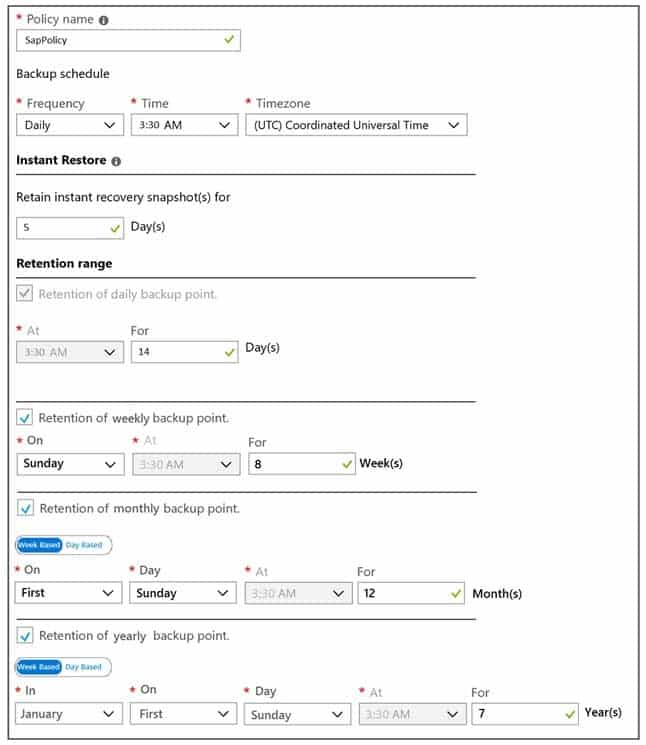
AZ-120 Part 01 Q02 001 Azure Resource Manager Template
An Azure administrator provides you with the Azure Resource Manager template that will be used to provision the production application servers.
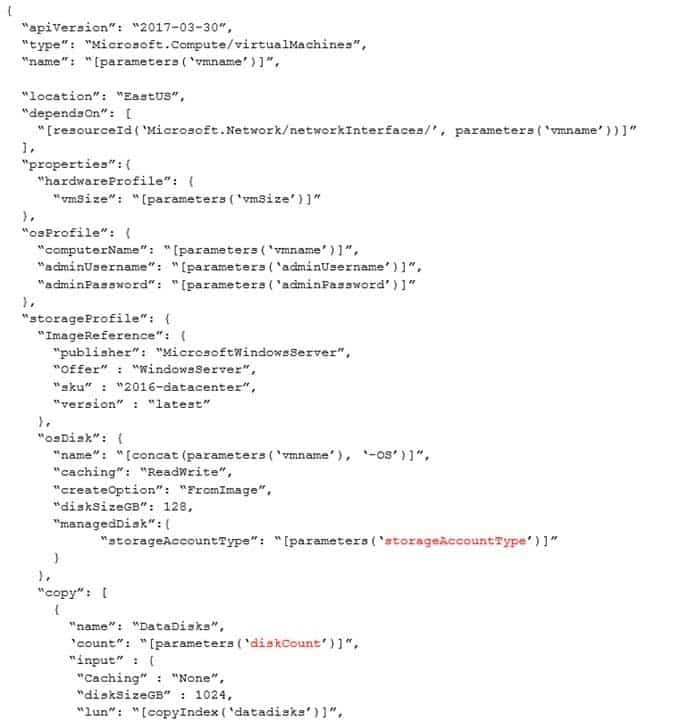
AZ-120 Part 01 Q02 002 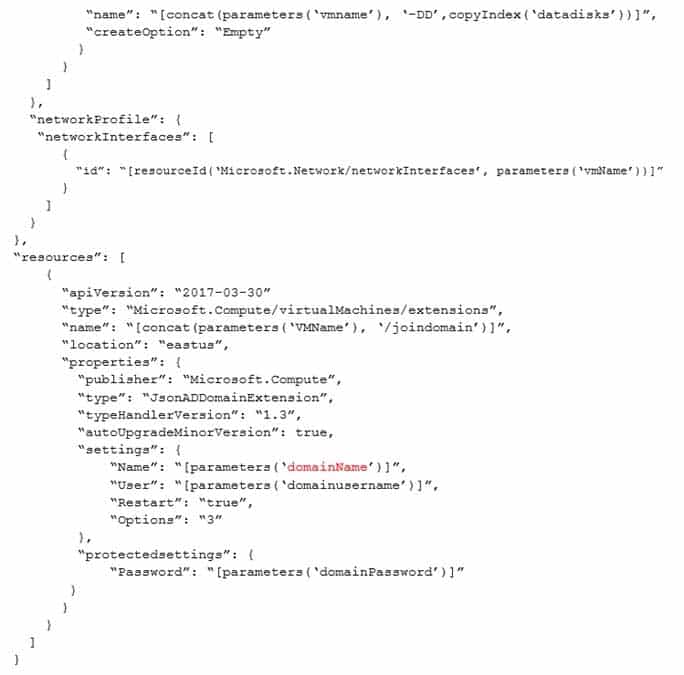
AZ-120 Part 01 Q02 003 -
HOTSPOT
You are evaluating the proposed backup policy.
For each of the following statements, select Yes if the statement is true. Otherwise, select No.
NOTE: Each correct selection is worth one point.

AZ-120 Part 01 Q02 004 Question 
AZ-120 Part 01 Q02 004 Answer Explanation:
Box 1: Yes
Scenario: Technical requirements: Ensure that an application server can be restored from a backup created during the last five days within 15 minutes.Instant Restore has ‘The instance recovery snapshot(s) for 5 Day(s)’.
Box 2: No
Scenario: Ensure that all the production application servers can restore daily backups from the last 21 days.The Retention of daily backup point is set to for 14 days only.
Box 3: Yes
-
HOTSPOT
You are planning replication of the SAP HANA database for the disaster recovery environment in Azure.
For each of the following statements, select Yes if the statement is true. Otherwise, select No.
NOTE: Each correct selection is worth one point.
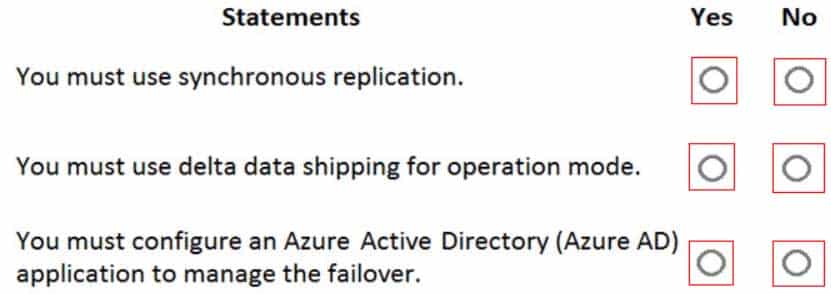
AZ-120 Part 01 Q02 005 Question 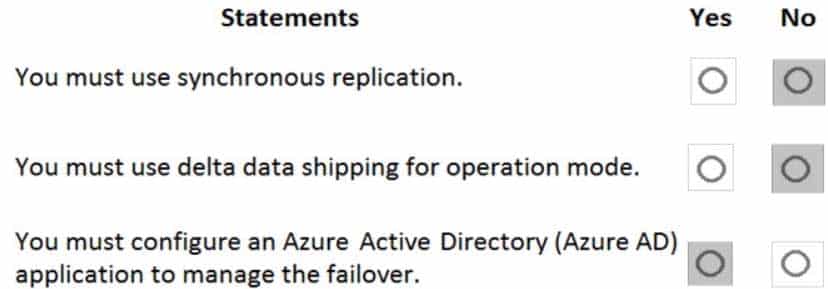
AZ-120 Part 01 Q02 005 Answer Explanation:
Box 1: No
SAP HANA Replication consists of one primary node and at least one secondary node. Changes to the data on the primary node are replicated to the secondary node synchronously or asynchronously.
Box 2: No
Since SPS11 SAP HANA system replication can be run in two different operation
modes:
– delta_datashipping
– logreplayBox 3: Yes
-
-
You are migrating SAP to Azure. The ASCS application servers are in one Azure zone, and the SAP database server in in a different Azure zone. ASCS/ERS is configured for high availability.
During performance testing, you discover increased response times in Azure, even though the Azure environment has better computer and memory configurations than the on-premises environment.
During the initial analysis, you discover an increased wait time for Enqueue.
What are three possible causes of the increased wait time? Each correct answer presents a complete solution.
NOTE: Each correct selection is worth one point.
- a missing Enqueue profile
- disk I/O during Enqueue backup operations
- misconfigured load balancer rules and health check probes for Enqueue and ASCS
- active Enqueue replication
- network latency between the database server and the SAP application servers
Explanation:
E: The network latency across Availability Zones is not the same in all Azure regions. In some cases, you can deploy and run the SAP application layer across different zones because the network latency from one zone to the active DBMS VM is acceptable. But in some Azure regions, the latency between the active DBMS VM and the SAP application instance, when deployed in different zones, might not be acceptable for SAP business processes.
-
You have an on-premises SAP environment that uses AIX servers and IBM DB2 as the database platform.
You plan to migrate SAP to Azure. In Azure, the SAP workloads will use Windows Server and Microsoft SQL Server as the database platform.
What should you use to export from DB2 and import the data to SQL Server?
- R3load
- Azure SQL Data Warehouse
- SQL Server Management Studio (SSMS)
- R3trans
Explanation:To migrate DB2 databases to SQL Server, you must connect to the DB2 database that you want to migrate. When you connect, SSMA obtains metadata about all DB2 schemas, and then displays it in the DB2 Metadata Explorer pane.
-
HOTSPOT
You are designing the backup for an SAP database.
You have an Azure Storage account that is configured as shown in the following exhibit.
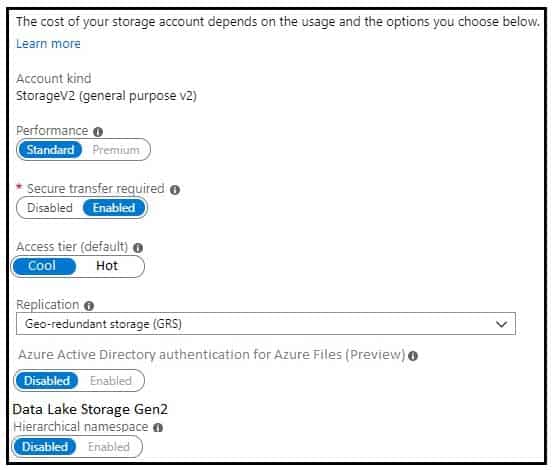
AZ-120 Part 01 Q05 006 Use the drop-down menus to select the answer choice that completes each statement based on the information presented in the graphic.
NOTE: Each correct selection is worth one point.

AZ-120 Part 01 Q05 007 Question 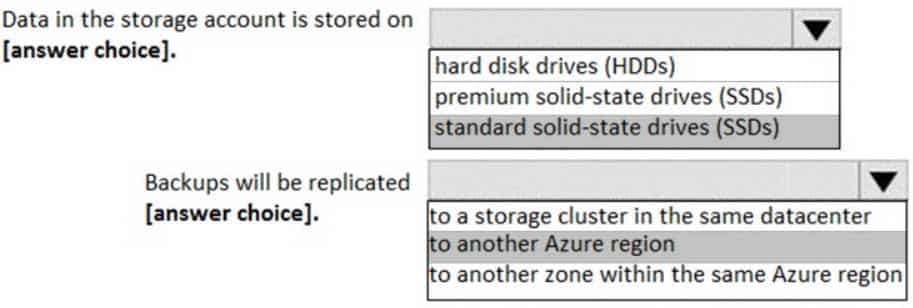
AZ-120 Part 01 Q05 007 Answer Explanation:
Box 1: standard solid-state drives (SSDs)
Standard SSD Managed Disks, a low-cost SSD offering, are optimized for test and entry-level production workloads requiring consistent latency.Box 2: to another Azure region
Geo-redundant storage (GRS) copies your data synchronously three times within a single physical location in the primary region using LRS. It then copies your data asynchronously to a single physical location in a secondary region that is hundreds of miles away from the primary region. -
DRAG DROP
You migrate SAP ERP Central Component (SAP ECC) production and non-production landscapes to Azure.
You are licensed for SAP Landscape Management (LaMa).
You need to refresh from the production landscape to the non-production landscape.
Which four actions should you perform in sequence? To answer, move the appropriate actions from the list of actions to the answer area and arrange them in the correct order.
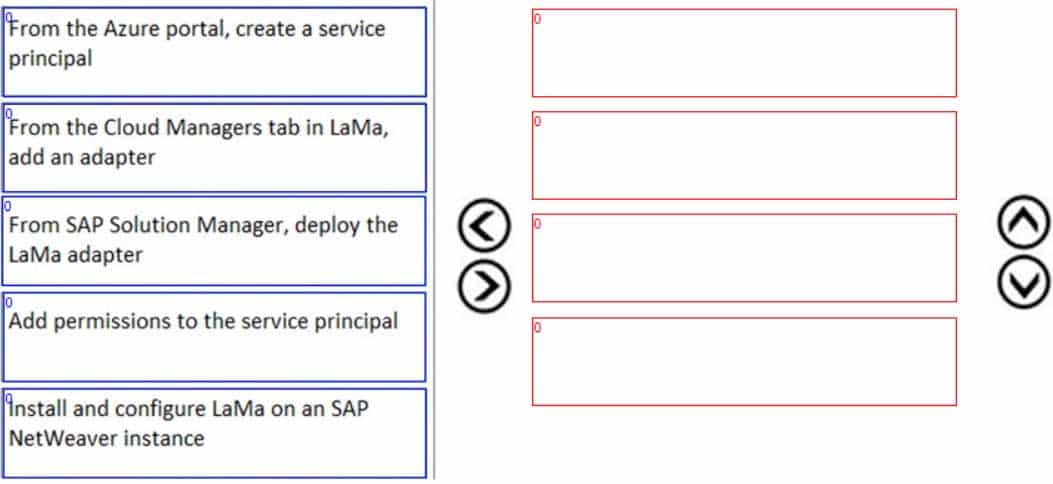
AZ-120 Part 01 Q06 008 Question 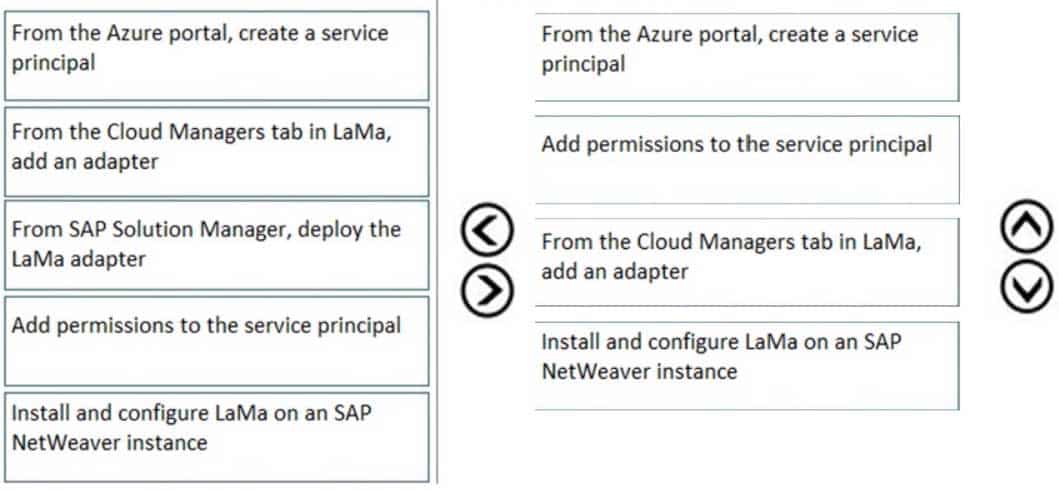
AZ-120 Part 01 Q06 008 Answer Explanation:
Step 1: From the Azure portal, create a service principal
The Azure connector can use a Service Principal to authorize against Microsoft Azure. Follow these steps to create a Service Principal for SAP Landscape Management (LaMa).Step 2: Add permissions to the service principal
The Service Principal does not have permissions to access your Azure resources by default. You need to give the Service Principal permissions to access them.Step 3: From the Cloud Managers tab in LaMa, add an adapter
Create a new connector in SAP LaMa
Open the SAP LaMa website and navigate to Infrastructure. Go to tab Cloud Managers and click on Add. Select the Microsoft Azure Cloud AdapterStep 4: Install and configure LaMA on an SAP NetWeater instance
Provision a new adaptive SAP system
You can manually deploy a new virtual machine or use one of the Azure templates in the quickstart repository. It contains templates for SAP NetWeaver ASCS, SAP NetWeaver application servers, and the database. You can also use these templates to provision new hosts as part of a system copy/clone etc.Note: To support customers on their journey into a cloud model (hybrid or entirely public cloud), SAP and Microsoft partnered to create an adapter that integrates the SAP management capabilities of LaMa with the IaaS advantages of Microsoft Azure.
-
HOTSPOT
For each of the following statements, select Yes if the statement is true. Otherwise, select No.
NOTE: Each correct selection is worth one point.
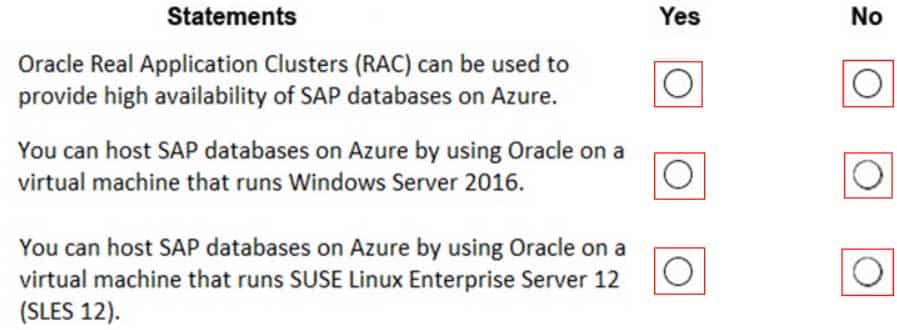
AZ-120 Part 01 Q07 009 Question 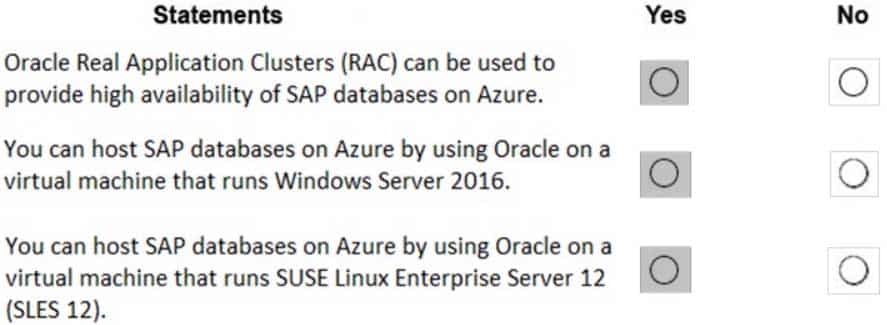
AZ-120 Part 01 Q07 009 Answer Explanation:
Box 1: Yes
Box 2: Yes
Oracle Database 12c Release 2 (12.2) is certified on Microsoft Windows Server 2016 (Standard, Datacenter, and Essentials Editions), which includes support for the database client, server, and Oracle Real Application Clusters.
Organizations can run SAP applications with Oracle databases on the same code base on Unix, Linux, and Windows operating systems.Box 3: Yes
-
You have an SAP environment that is managed by using VMware vCenter.
You plan to migrate the SAP environment to Azure.
You need to gather information to identify which compute resources are required in Azure.
What should you use to gather the information?
- Azure Migrate and SAP EarlyWatch Alert reports
- Azure Site Recovery and SAP Quick Sizer
- SAP Quick Sizer and SAP HANA system replication
- Azure Site Recovery Deployment Planner and SAP HANA Cockpit
Explanation:
Azure Migrate is a Microsoft service that helps an enterprise assess how its on-premises workloads will perform, and how much they will cost to host, in the Azure public cloud.
An enterprise can use Azure Migrate to discover information about the VMware VMs running within its own data center, including CPU and memory usage, as well as performance history.SAP Early Watch Alert (EWA) is a monitoring service for SAP customers, to monitor SAP systems in the solution landscape.
Incorrect Answers:
D: SAP HANA Cockpit is an administrative tool with a web interface for a correspondingly named database engine, a part of SAP ERP software. It allows both offline and cloud operations for managing databases, -
You plan to migrate an SAP ERP Central Component (SAP ECC) production system to Azure.
You are reviewing the SAP EarlyWatch Alert report for the system.
You need to recommend sizes for the Azure virtual machines that will host the system.
Which two sections of the report should you review? Each correct answer presents a complete solution.
NOTE: Each correct selection is worth one point.
- Hardware Capacity
- Patch Levels under SAP Software Configuration
- Hardware Configuration under Landscape
- Database and ABAP Load Optimization
- Data Volume Management
Explanation:
It is important to note that there are 2 types of data collected for Hardware Capacity.Performance Data – e.g. CPU and Memory utilization data.
Hardware Capacity data shown in the EWA is measuring CPU and Memory utilization data. This is known as Performance Data.Configuration Data – e.g. OS information, CPU type.
It is also collecting system information about the host such as hardware manufacturer, CPU type etc. This is known as Configuration Data.Incorrect Answers:
E: Data Volume Management focuses on whether the collection of DVM content for the EarlyWatch Alert report is not performed, not activated, or not possible because the SAP Solution Manager system does not meet the technical requirements. -
You plan to migrate an SAP environment to Azure.
You need to recommend a solution to migrate the SAP application servers to Azure. The solution must minimize downtime and changes to the environments.
What should you include in the recommendation?
- Azure Storage Explorer
- Azure Import/Export service
- AzCopy
- Azure Site Recovery
-
You plan to migrate an on-premises SAP development system to Azure.
Before the migration, you need to check the usage of the source system hardware, such as CPU, memory, network, etc.
Which transaction should you run from SAP GUI?
- SM51
- DB01
- DB12
- OS07N
Explanation:
SAP transaction OS07N (Remote Operating System Activity) is classified in the Basis Component module under application component Operating System Monitors and runs Monitoring Operating System program RSHOST1N upon execution.Incorrect Answers:
A: Transaction code SM51 is to display list of active application servers that have registered in the SAP message server.B: DB01 is a transaction code used for Analyze Exclusive Lockwaits in SAP.
C: Transaction code DB12 is to collects and presents information that is necessary to monitor database backups.
-
Your company has an SAP environment that contains the following components:
– SAP systems based on SAP HANA and SAP Adaptive Server Enterprise (SAP ASE) that run on SUSE Linux Enterprise Server 12 (SLES 12)
– Multiple SAP applicationsThe company plans to migrate all the applications to Azure.
You need to get a comprehensive list of all the applications that are part of the SAP environment.
What should you use?
- the SAP license information
- the SAP Solution Manager
- the data volume management report
- the network inventory and locations
Explanation:
The SAP Solution Manager is a centralized robust application management and administration solution used to implement, support, operate and monitor your SAP enterprise solutions, SAP Solution Manager is a platform providing integrated content, tools, methodologies and access to SAP systems.Incorrect Answers:
C: Data volume management is a framework that helps the solution operations team of an SAP-centric solution to balance the need of business’ access to a wealth of data and IT efforts to monitor and control data growth and to minimize data volume. -
Note: This question is part of a series of questions that present the same scenario. Each question in the series contains a unique solution that might meet the stated goals. Some question sets might have more than one correct solution, while others might not have a correct solution.
After you answer a question in this section, you will NOT be able to return to it. As a result, these questions will not appear in the review screen.
You plan to migrate an SAP HANA instance to Azure.
You need to gather CPU metrics from the last 24 hours from the instance.
Solution: You query views from SAP HANA Studio.
Does this meet the goal?
- Yes
- No
Explanation:
The SAP HANA cockpit provides a single point of access to a range of SAP HANA administration and monitoring tasks. It is used to monitor and ensure the overall health of the system.The HANA Monitoring dashboard also visualizes key HANA Metrics of SAP HANA system.
-
Note: This question is part of a series of questions that present the same scenario. Each question in the series contains a unique solution that might meet the stated goals. Some question sets might have more than one correct solution, while others might not have a correct solution.
After you answer a question in this section, you will NOT be able to return to it. As a result, these questions will not appear in the review screen.
You plan to migrate an SAP HANA instance to Azure.
You need to gather CPU metrics from the last 24 hours from the instance.
Solution: You run SAP HANA Quick Sizer.
Does this meet the goal?
- Yes
- No
Explanation:
The SAP HANA cockpit provides a single point of access to a range of SAP HANA administration and monitoring tasks. It is used to monitor and ensure the overall health of the system.The HANA Monitoring dashboard also visualizes key HANA Metrics of SAP HANA system.
-
Note: This question is part of a series of questions that present the same scenario. Each question in the series contains a unique solution that might meet the stated goals. Some question sets might have more than one correct solution, while others might not have a correct solution.
After you answer a question in this section, you will NOT be able to return to it. As a result, these questions will not appear in the review screen.
You plan to migrate an SAP HANA instance to Azure.
You need to gather CPU metrics from the last 24 hours from the instance.
Solution: You use DBA Cockpit from SAP GUI.
Does this meet the goal?
- Yes
- No
Explanation:
The SAP HANA cockpit provides a single point of access to a range of SAP HANA administration and monitoring tasks. It is used to monitor and ensure the overall health of the system.The HANA Monitoring dashboard also visualizes key HANA Metrics of SAP HANA system.
-
Note: This question is part of a series of questions that present the same scenario. Each question in the series contains a unique solution that might meet the stated goals. Some question sets might have more than one correct solution, while others might not have a correct solution.
After you answer a question in this section, you will NOT be able to return to it. As a result, these questions will not appear in the review screen.
You have a complex SAP environment that has both ABAP- and Java-based systems. The current on-premises landscapes are based on SAP NetWeaver 7.0 (Unicode and Non-Unicode) running on Windows Server and Microsoft SQL Server.
You need to migrate the SAP environment to a HANA-certified Azure environment.
Solution: You deploy a new environment to Azure that uses SAP NetWeaver 7.4. You export the databases from the on-premises environment, and then you import the databases into the Azure environment.
Does this meet the goal?
- Yes
- No
Explanation:
Instead use Azure Site Recovery to migrate. -
Note: This question is part of a series of questions that present the same scenario. Each question in the series contains a unique solution that might meet the stated goals. Some question sets might have more than one correct solution, while others might not have a correct solution.
After you answer a question in this section, you will NOT be able to return to it. As a result, these questions will not appear in the review screen.
You have a complex SAP environment that has both ABAP- and Java-based systems. The current on-premises landscapes are based on SAP NetWeaver 7.0 (Unicode and Non-Unicode) running on Windows Server and Microsoft SQL Server.
You need to migrate the SAP environment to a HANA-certified Azure environment.
Solution: You upgrade to SAP NetWeaver 7.4, and then you migrate SAP to Azure by using Azure Site Recovery.
Does this meet the goal?
- Yes
- No
Explanation:We need upgrade to SAP NetWeaver 7.4 before the migration. Then Azure Site Recovery is used for the migration to Azure.
-
Note: This question is part of a series of questions that present the same scenario. Each question in the series contains a unique solution that might meet the stated goals. Some question sets might have more than one correct solution, while others might not have a correct solution.
After you answer a question in this section, you will NOT be able to return to it. As a result, these questions will not appear in the review screen.
You have a complex SAP environment that has both ABAP- and Java-based systems. The current on-premises landscapes are based on SAP NetWeaver 7.0 (Unicode and Non-Unicode) running on Windows Server and Microsoft SQL Server.
You need to migrate the SAP environment to a HANA-certified Azure environment.
Solution: You migrate SAP to Azure by using Azure Site Recovery, and then you upgrade to SAP NetWeaver 7.4.
Does this meet the goal?
- Yes
- No
Explanation:We need upgrade to SAP NetWeaver 7.4 before the migration.
-
HOTSPOT
A company named Contoso, Ltd. has users across the globe. Contoso is evaluating whether to migrate SAP to Azure.
The SAP environment runs on SUSE Linux Enterprise Server (SLES) servers and SAP HANA databases. The Suite on HANA database is 4 TB.
You need to recommend a migration solution to migrate SAP application servers and the SAP HANA databases. The solution must minimize downtime.
Which migration solutions should you recommend? To answer, select the appropriate options in the answer area.
NOTE: Each correct selection is worth one point.
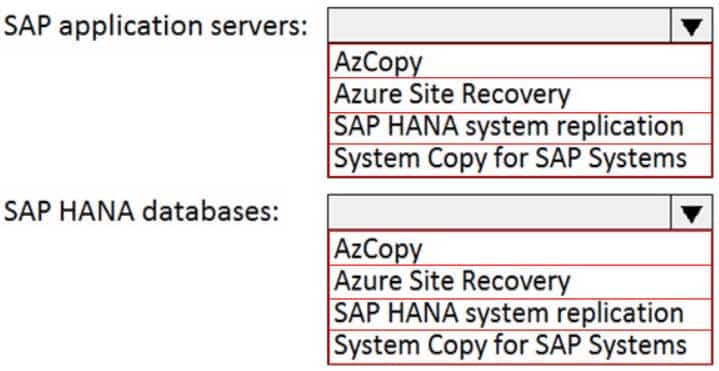
AZ-120 Part 01 Q19 010 Question 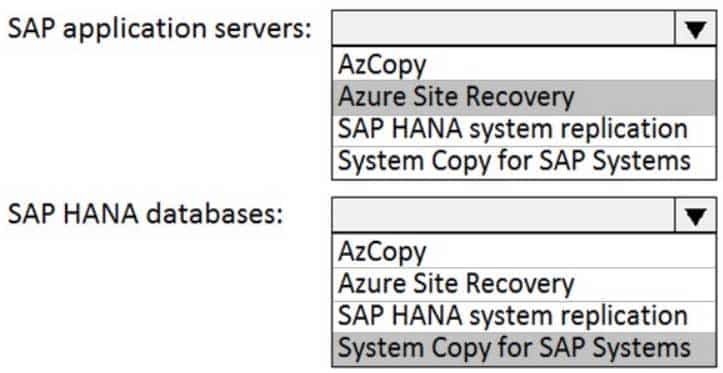
AZ-120 Part 01 Q19 010 Answer Explanation:
Box 1: Azure Site Recovery
Microsoft Azure Site Recovery (ASR) now supports SUSE Linux Enterprise Server 11 SP3/SP4 and SUSE Linux Enterprise Server 12 SP1/SP2/SP3. This is great for customers that are planning to migrate systems to Microsoft Azure or customers who need to have a business continuity strategy for their Azure deployments.Azure Site Recovery enables SUSE customers to migrate their non-Azure virtual machines or physical servers to Microsoft Azure virtual machines.
Box 2: System Copy for SAP Systems
In order to migrate an existing SAP HANA system into Azure, a SAP homogeneous system copy can be performed. -
You have an on-premises SAP environment hosted on VMware VSphere that uses Microsoft SQL Server as the database platform.
You plan to migrate the environment to Azure. The database platform will remain the same.
You need gather information to size the target Azure environment for the migration.
What should you use?
- the SAP EarlyWatch report
- Azure Advisor
- the SAP HANA sizing report
- Azure Monitor
Explanation:
Azure Advisor provides recommendations for Application Gateway, App Services, availability sets, Azure Cache, Azure Data Factory, Azure Database for MySQL, Azure Database for PostgreSQL, Azure Database for MariaDB, Azure ExpressRoute, Azure Cosmos DB, Azure public IP addresses, SQL Data Warehouse, SQL servers, storage accounts, Traffic Manager profiles, and virtual machines.Note: Advisor is a personalized cloud consultant that helps you follow best practices to optimize your Azure deployments. It analyzes your resource configuration and usage telemetry and then recommends solutions that can help you improve the cost effectiveness, performance, high availability, and security of your Azure resources.
With Advisor, you can:
Get proactive, actionable, and personalized best practices recommendations.
Improve the performance, security, and high availability of your resources, as you identify opportunities to reduce your overall Azure spend.
Get recommendations with proposed actions inline.Incorrect Answers:
A: The SAP Early Watch report is a monitoring tool that monitors the essential administrative areas of SAP components and keeps you up to date on their performance and stability. SAP Early Watch Alert runs automatically to keep you informed, so you can react to issues proactively, before they become critical.